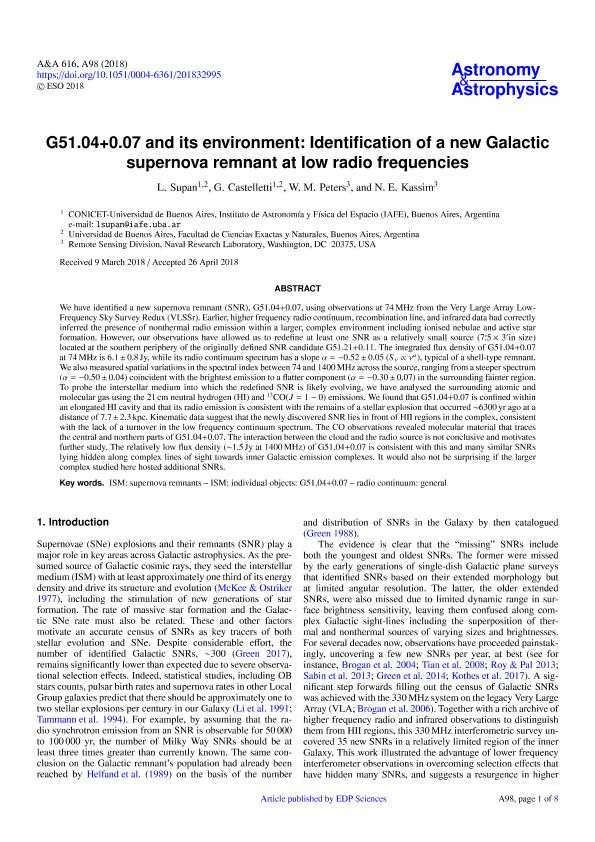Mostrar el registro sencillo del ítem
dc.contributor.author
Supán, Jorge Leonardo

dc.contributor.author
Castelletti, Gabriela Marta

dc.contributor.author
Peters, W. M.
dc.contributor.author
Kassim, N. E.
dc.date.available
2019-07-31T17:10:11Z
dc.date.issued
2018-04
dc.identifier.citation
Supán, Jorge Leonardo; Castelletti, Gabriela Marta; Peters, W. M.; Kassim, N. E.; G51.04+0.07 and its environment: Identification of a new Galactic supernova remnant at low radio frequencies; EDP Sciences; Astronomy and Astrophysics; 616; 4-2018; 98-106
dc.identifier.issn
0004-6361
dc.identifier.uri
http://hdl.handle.net/11336/80680
dc.description.abstract
We have identified a new supernova remnant (SNR), G51.04+0.07, using observations at 74 MHz from the Very Large Array Low-Frequency Sky Survey Redux (VLSSr). Earlier, higher frequency radio continuum, recombination line, and infrared data had correctly inferred the presence of nonthermal radio emission within a larger, complex environment including ionised nebulae and active star formation. However, our observations have allowed us to redefine at least one SNR as a relatively small source (7.05 × 30in size) located at the southern periphery of the originally defined SNR candidate G51.21+0.11. The integrated flux density of G51.04+0.07 at 74 MHz is 6.1 ± 0.8 Jy, while its radio continuum spectrum has a slope α = −0.52 ± 0.05 (Sν ∝ να), typical of a shell-type remnant. We also measured spatial variations in the spectral index between 74 and 1400 MHz across the source, ranging from a steeper spectrum (α = −0.50 ± 0.04) coincident with the brightest emission to a flatter component (α = −0.30 ± 0.07) in the surrounding fainter region. To probe the interstellar medium into which the redefined SNR is likely evolving, we have analysed the surrounding atomic and molecular gas using the 21 cm neutral hydrogen (HI) and 13CO(J = 1 − 0) emissions. We found that G51.04+0.07 is confined within an elongated HI cavity and that its radio emission is consistent with the remains of a stellar explosion that occurred ∼6300 yr ago at a distance of 7.7 ± 2.3 kpc. Kinematic data suggest that the newly discovered SNR lies in front of HII regions in the complex, consistent with the lack of a turnover in the low frequency continuum spectrum. The CO observations revealed molecular material that traces the central and northern parts of G51.04+0.07. The interaction between the cloud and the radio source is not conclusive and motivates further study. The relatively low flux density (∼1.5 Jy at 1400 MHz) of G51.04+0.07 is consistent with this and many similar SNRs lying hidden along complex lines of sight towards inner Galactic emission complexes. It would also not be surprising if the larger complex studied here hosted additional SNRs.
dc.format
application/pdf
dc.language.iso
eng
dc.publisher
EDP Sciences

dc.rights
info:eu-repo/semantics/openAccess
dc.rights.uri
https://creativecommons.org/licenses/by-nc-sa/2.5/ar/
dc.subject
Ism: Individual Objects: G51.04+0.07
dc.subject
Ism: Supernova Remnants
dc.subject
Radio Continuum: General
dc.subject.classification
Astronomía

dc.subject.classification
Ciencias Físicas

dc.subject.classification
CIENCIAS NATURALES Y EXACTAS

dc.title
G51.04+0.07 and its environment: Identification of a new Galactic supernova remnant at low radio frequencies
dc.type
info:eu-repo/semantics/article
dc.type
info:ar-repo/semantics/artículo
dc.type
info:eu-repo/semantics/publishedVersion
dc.date.updated
2019-07-29T14:53:37Z
dc.journal.volume
616
dc.journal.pagination
98-106
dc.journal.pais
Francia

dc.journal.ciudad
Paris
dc.description.fil
Fil: Supán, Jorge Leonardo. Consejo Nacional de Investigaciónes Científicas y Técnicas. Oficina de Coordinación Administrativa Ciudad Universitaria. Instituto de Astronomía y Física del Espacio. - Universidad de Buenos Aires. Facultad de Ciencias Exactas y Naturales. Instituto de Astronomía y Física del Espacio; Argentina
dc.description.fil
Fil: Castelletti, Gabriela Marta. Consejo Nacional de Investigaciónes Científicas y Técnicas. Oficina de Coordinación Administrativa Ciudad Universitaria. Instituto de Astronomía y Física del Espacio. - Universidad de Buenos Aires. Facultad de Ciencias Exactas y Naturales. Instituto de Astronomía y Física del Espacio; Argentina
dc.description.fil
Fil: Peters, W. M.. Spece Sciences División. Naval Research Laboratory; Estados Unidos
dc.description.fil
Fil: Kassim, N. E.. Spece Sciences División. Naval Research Laboratory; Estados Unidos
dc.journal.title
Astronomy and Astrophysics

dc.relation.alternativeid
info:eu-repo/semantics/altIdentifier/url/https://www.aanda.org/articles/aa/abs/2018/08/aa32995-18/aa32995-18.html
dc.relation.alternativeid
info:eu-repo/semantics/altIdentifier/doi/http://dx.doi.org/10.1051/0004-6361/201832995
Archivos asociados
